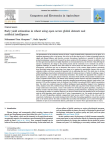Akcapinar M.C., Apaydin H. (2025). Early yield estimation in wheat using open access global datasets and artificial intelligence. Computers and Electronics in Agriculture, 01/01/2025, vol. 237, p. 110486.
https://doi.org/10.1016/j.compag.2025.110486
https://doi.org/10.1016/j.compag.2025.110486
| Titre : | Early yield estimation in wheat using open access global datasets and artificial intelligence (2025) |
| Auteurs : | M.C. Akcapinar ; H. Apaydin |
| Type de document : | Article |
| Dans : | Computers and Electronics in Agriculture (vol. 237, 2025) |
| Article en page(s) : | p. 110486 |
| Langues : | Anglais |
| Langues du résumé : | Anglais |
| Catégories : |
Catégories principales 06 - AGRICULTURE. FORÊTS. PÊCHES ; 6.4 - Production Agricole. Système de ProductionThésaurus IAMM RENDEMENT DES CULTURES ; CEREALICULTURE ; BLE ; PREVISION DE RENDEMENT ; INTELLIGENCE ARTIFICIELLE ; DONNEE STATISTIQUE |
| Résumé : | The determination of the production amount of wheat, a staple foodstuff widely cultivated across the globe, is of significant importance prior to the harvest. This is due to the fact that the price of wheat is dependent upon the supply and demand balance, and therefore, accurate forecasting of production is essential for effective food production planning. A great deal of research has been conducted for this purpose. However, in addition to the fact that agricultural production is highly dependent on environmental factors, the diversity of data affecting the amount of production, the change in the growing season and the constraints on its continuity can present a significant challenge. In instances where data cannot be sourced from local data sources or there is a lack of homogeneity, researchers may turn to alternative data sources. In this context, digital products, particularly those developed using satellite technology, have begun to be employed in agricultural contexts, such as yield estimation studies, and have assumed an important role in addressing this need. This study aims to develop artificial intelligence-based wheat yield prediction models for Ankara province in Türkiye by utilizing a range of global datasets that are accessible to international researchers. The models were populated with a number of input parameters, including the Spatial Production Allocation Model (SPAM) wheat-masked Normalized Difference Vegetation Index (NDVI), the Famine Early Warning Systems Network Land Data Assimilation System (FLDAS) evapotranspiration, the Moderate Resolution Imaging Spectroradiometer (MODIS) Land Surface Temperature (LST) and the European Centre for Medium-Term Weather Forecasting (ECMWF) AgERA5 precipitation data. The study was conducted using four artificial intelligence-based algorithms (Support Vector Regression (SVR), Random Forest (RF), Artificial Neural Networks (ANN) and Long Short-Term Memory (LSTM)) in the Google Colaboratory environment. A total of 180 models were developed using these algorithms, comprising 15 different scenarios and three distinct approaches to optimizing model performance, facilitating early prediction and reducing the number of variables employed. The most successful model was identified as the one developed with the LSTM algorithm, which achieved an R2 value of approximately 0.96. The models developed with the ANN, RF, and SVR algorithms exhibited comparatively lower success, with R2 values of 0.86, 0.84, and 0.76, respectively. Furthermore, the model developed with LSTM offers forecasting capabilities at least three months prior to the harvest period. The study concluded that successful yield estimation can be achieved through the utilization of open access international datasets, particularly in scenarios where agricultural data are scarce. |
| Cote : | Réservé lecteur CIHEAM |
| URL / DOI : | https://doi.org/10.1016/j.compag.2025.110486 |







